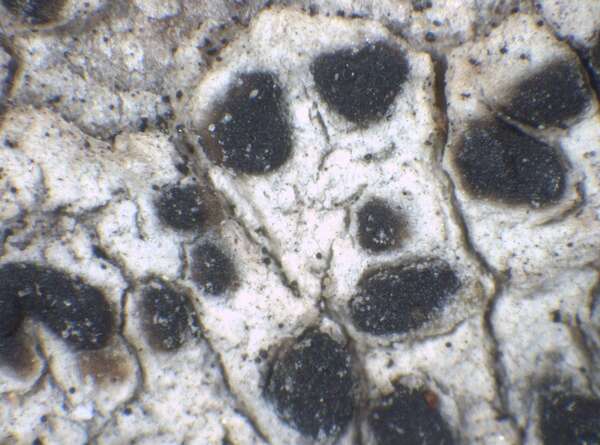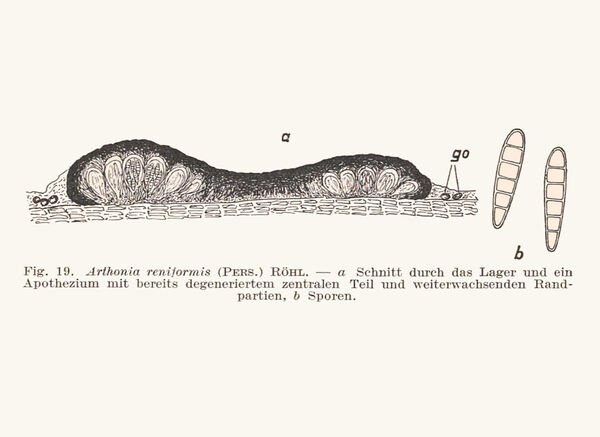Arthonia reniformis (Pers.) Nyl.
Flora, 59: 330, 1867. Basionym: Opegrapha reniformis Pers. - Ann. Bot. (Usteri), 7: 31, tab. II, fig. C, 1794.
Synonyms: Arthonia gyrosa Ach.; Arthonia obscura Ach.; Arthonia reniformis (Pers.) Röhl.; Arthonia vulgaris var. obscura (Ach.) Schaer.; Naevia gyrosa (Ach.) A. Massal.
Description: Thallus crustose, episubstratic, thin, mostly continuous, strongly rugose, somewhat shiny, whitish to greenish grey, sometimes delimited by a dark prothalline line. Apothecia arthonioid, emarginate, black, round to irregularly lobed, 0.3-1(-1.5) mm across, 0.8-0.12 mm tall, often crowded and confluent, with a flat to slightly convex, epruinose disc, the central parts often degrading. Proper exciple poorly developed, reddish brown, of paraphysoid-like hyphae, 8-15 μm wide; epithecium brown-black, 10-25 µm high; hymenium colourless to pale reddish brown, 25-50 µm high, I+ reddish orange, K/I+ blue; paraphysoids coherent, richly branched, orientated in all directions, 1-1.5 μm thick at mid-level, the apical cells without a dark cap; hypothecium colourless to pale yellowish brown. Asci 8-spored, broadly clavate, semi-fissitunicate, with a large apical dome and a distinct ocular chamber, the tholus without horizontal layers, Arthonia-type. Ascospores 5-6-septate, hyaline but turning brownish when overmature, narrowly ellipsoid, pointed at one end, (12-)13-18(-20) x 4-6(-7) µm, the wall persistently smooth, surrounded by a thin gelatinous sheath. Pycnidia black, semi-immersed in the thallus. Conidia bacilliform, curved, (2-)3-4 x c. 1 µm. Photobiont trentepohlioid. Spot tests: thallus K- or K+ yellowish brown, C-, KC-, P-, UV-. Chemistry: without lichen substances.
Growth form: Crustose
Substrata: bark
Photobiont: Trentepohlia
Reproductive strategy: mainly sexual
Commonnes-rarity: (info)
Alpine belt: absent
Subalpine belt: absent
Montane belt: extremely rare
Dry submediterranean belt: extremely rare
Humid submediterranean belt: very rare
Padanian area: absent
pH of the substrata:
1 2 3 4 5
Solar irradiation:
1 2 3 4 5
Aridity:
1 2 3 4 5
Eutrophication:
1 2 3 4 5
Poleotolerance:
0 1 2 3
Altitudinal distribution:
1 2 3 4 5 6
Rarity
absent
extremely rare
very rare
rare
rather rare
rather common
common
very common
extremely common
Loading data...
Occurrence data
Predictive map
Growth form: Crustose
Substrata: bark
Photobiont: Trentepohlia
Reproductive strategy: mainly sexual
Commonnes-rarity: (info)
Alpine belt: absent
Subalpine belt: absent
Montane belt: extremely rare
Dry submediterranean belt: extremely rare
Humid submediterranean belt: very rare
Padanian area: absent
pH of the substrata:
| 1 | 2 | 3 | 4 | 5 |
Solar irradiation:
| 1 | 2 | 3 | 4 | 5 |
Aridity:
| 1 | 2 | 3 | 4 | 5 |
Eutrophication:
| 1 | 2 | 3 | 4 | 5 |
Poleotolerance:
| 0 | 1 | 2 | 3 |
Altitudinal distribution:
| 1 | 2 | 3 | 4 | 5 | 6 |
Rarity
absent
extremely rare
very rare
rare
rather rare
rather common
common
very common
extremely common
Loading data...
Occurrence data
Predictive map








